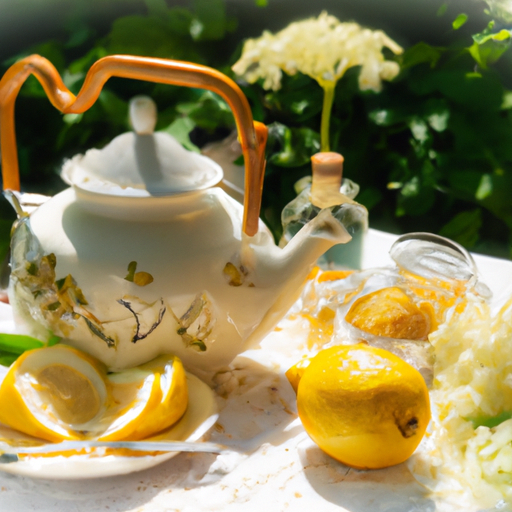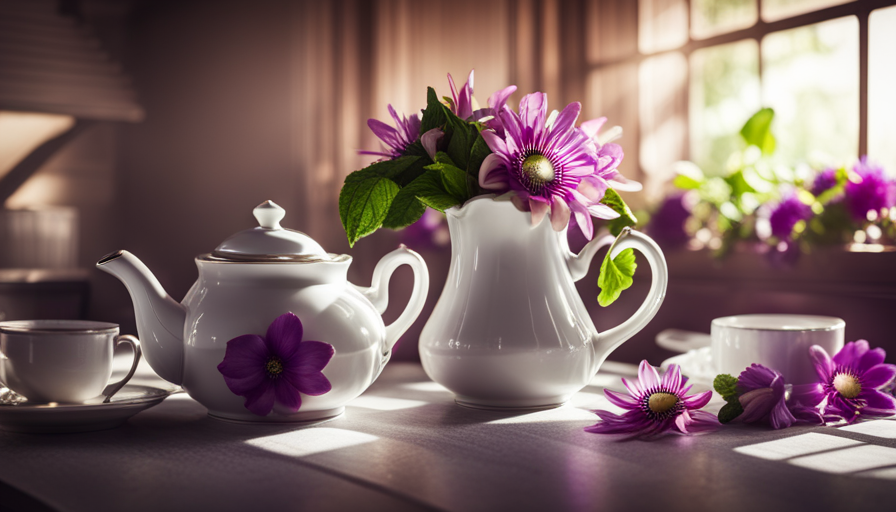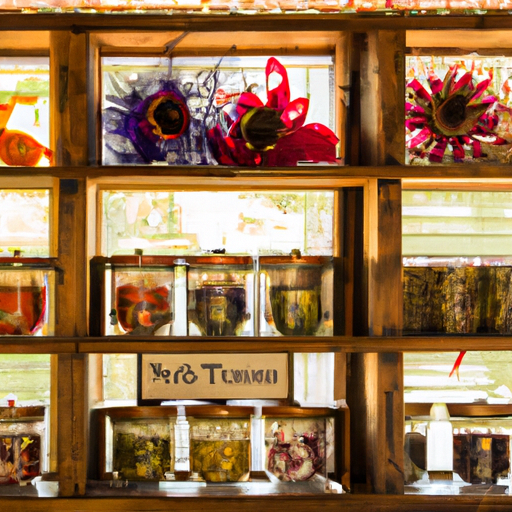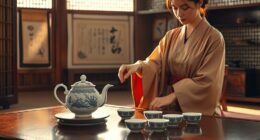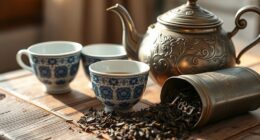Oh, the delicate dance of steeping jasmine flower tea. How long should one wait for those fragrant petals to infuse their magic into the hot water? It’s a question that tea enthusiasts often ponder, and one that I am here to answer.
Steeping time is a crucial factor in achieving the perfect cup of jasmine flower tea. Too short, and you may miss out on the full flavor and aroma. Too long, and bitterness may creep in, leaving you with a less-than-ideal experience.
In this article, I will guide you through the art of steeping jasmine flower tea, sharing the recommended time for maximum flavor, factors that affect steeping time, and helpful tips to ensure a delightful tea-drinking experience.
So, grab your favorite tea cup and let’s dive into the world of jasmine flower tea steeping!
Key Takeaways
- Steeping time for jasmine flower tea is crucial for achieving the perfect cup.
- Too short of a steeping time results in a weaker taste, while too long leads to bitterness.
- The recommended steeping time for jasmine flower tea is around 3 minutes.
- Adjusting the steeping time greatly affects the flavor and strength of the tea.
The Importance of Steeping Time
You’ll want to let the jasmine flower tea steep for at least three minutes, allowing the fragrant blossoms to dance and infuse their delicate flavors into the hot water. Steeping time plays a crucial role in determining the taste and aroma of jasmine flower tea. Understanding the science behind steeping time can help you make the most of your tea experience.
The flavors and aromas of jasmine flower tea are released through the infusion process. Steeping time affects the rate at which the compounds in the flowers dissolve into the water. When the tea is steeped for too short a time, the flavors may not fully develop, resulting in a weaker taste. Conversely, steeping the tea for too long can lead to a bitter or overpowering flavor.
Varying the steeping time can also offer different benefits. A shorter steeping time of around three minutes can yield a lighter and more delicate flavor, perfect for those who prefer a milder taste. On the other hand, a longer steeping time of five to seven minutes can produce a stronger and more robust flavor profile, ideal for those who enjoy a bolder tea experience.
Understanding the flavor profile of jasmine flower tea is essential for customizing your steeping time. By experimenting with different steeping durations, you can find the perfect balance that suits your personal preferences.
Now, let’s delve into the nuances of jasmine flower tea’s flavor profile.
Understanding the Flavor Profile of Jasmine Flower Tea
Indulge in the aromatic dance of delicate petals and invigorating sips as the nuanced flavors of this enchanting brew transport you to a serene garden oasis. Jasmine flower tea is renowned for its captivating aroma and exquisite taste. To truly appreciate its flavor profile, it’s essential to understand the intricate balance of floral notes and the health benefits it offers.
-
Fragrant Bliss: The intoxicating scent of jasmine flowers is infused into the tea leaves, creating a harmonious blend that delights the senses. The aroma alone can uplift your mood and create a sense of tranquility.
-
Healthful Delight: Beyond its delightful fragrance, jasmine flower tea is packed with health benefits. It’s rich in antioxidants that help fight against free radicals, promoting overall well-being. Additionally, it may aid digestion and support a healthy immune system.
-
Soothing Elixir: The smooth, delicate taste of jasmine flower tea is both calming and refreshing. It offers a subtle sweetness with a hint of floral essence, making each sip a soothing experience.
As we delve into the recommended steeping time for maximum flavor, it’s important to understand the complexity of jasmine flower tea and how its flavors develop.
Recommended Steeping Time for Maximum Flavor
Immerse yourself in the captivating experience of unlocking the full potential of this enchanting brew by discovering the perfect amount of time to steep for maximum flavor. When it comes to steeping jasmine flower tea, there are a few key techniques to keep in mind.
The recommended steeping time for maximum flavor is between 2 to 4 minutes. This allows the delicate floral notes of jasmine to infuse into the tea, creating a harmonious blend of flavors. However, it’s important to note that steeping time can vary depending on personal preference. If you prefer a stronger, more robust flavor, you can extend the steeping time by an additional minute or two.
Aside from the delightful taste, jasmine flower tea also offers numerous health benefits. It’s rich in antioxidants, which can help protect the body against free radicals. Additionally, it’s been known to promote relaxation and reduce stress levels. The soothing aroma of jasmine can have a calming effect on the mind and body, making it the perfect beverage to enjoy after a long day.
As we delve into the factors that affect steeping time, it’s important to consider the quality of the tea leaves, water temperature, and the vessel used for steeping. These factors can greatly influence the flavor and strength of the tea. So, let’s explore these aspects further in order to unlock the full potential of your jasmine flower tea.
Factors that Affect Steeping Time
When considering the factors that impact steeping time, it’s essential to take into account the quality of the leaves, the temperature of the water, and the vessel used for brewing. These factors can greatly affect the infusion time and ultimately the flavor of your jasmine flower tea.
The quality of the leaves plays a significant role in determining how long you should steep your tea. Higher quality leaves often require a shorter steeping time as they release their flavors more quickly. On the other hand, lower quality leaves may need a longer steeping time to fully develop their flavors.
The temperature of the water is another crucial factor. For jasmine flower tea, it’s recommended to use water that’s around 175°F (80°C). Steeping the tea at a lower temperature allows for a more delicate infusion, preserving the subtle floral notes of the jasmine.
The vessel used for brewing can also affect the steeping time. Using a smaller teapot or teacup can lead to a quicker infusion, while a larger vessel may require a longer steeping time to achieve the desired flavor.
Considering these factors, it’s important to adjust your steeping time accordingly to achieve the optimal flavor profile for your jasmine flower tea. Now, let’s move on to some helpful tips for steeping this delightful tea.
Tips for Steeping Jasmine Flower Tea
Enhance your brewing experience by using a fine mesh infuser or a glass teapot to showcase the vibrant colors and delicate aromas of your jasmine flower tea. These tools allow for a more controlled steeping process, ensuring that you extract the maximum flavor and aroma from the tea leaves.
When steeping jasmine flower tea, there are a few key tips to keep in mind. First, experiment with different water temperatures to find the one that suits your taste preferences. Jasmine flower tea can be steeped in water that’s anywhere from 175°F to 195°F (80°C to 90°C). Adjusting the water temperature can result in variations in taste, allowing you to customize your cup of tea to your liking.
Second, take the time to understand the health benefits associated with jasmine flower tea. It’s known for its calming properties, promoting relaxation and reducing stress levels. Additionally, it’s rich in antioxidants, which can help boost your immune system and protect against certain diseases.
Transitioning into the next section about experimenting with steeping time for personal preference, it’s important to note that the length of steeping time can greatly affect the flavor and strength of your tea.
Experimenting with Steeping Time for Personal Preference
Discover the blissful art of finding your perfect cup of aromatic delight through the enchanting dance of steeping time. When it comes to jasmine flower tea, experimenting with different brewing methods can help you achieve the desired flavor and aroma. One important factor to consider is the impact of water temperature on steeping time. To help you navigate this journey, I have created a table that showcases the different steeping times based on water temperature.
| Water Temperature | Steeping Time |
|---|---|
| 175°F (79°C) | 1-2 minutes |
| 185°F (85°C) | 2-3 minutes |
| 195°F (90°C) | 3-4 minutes |
| 205°F (96°C) | 4-5 minutes |
By adjusting the water temperature, you can control the intensity of the jasmine flavor. If you prefer a milder taste, go for a lower temperature and shorter steeping time. On the other hand, if you want a stronger and more fragrant cup, opt for higher temperatures and longer steeping times.
Now that you have mastered the art of experimenting with steeping time, let’s move on to the next section to learn about avoiding oversteeping and bitterness in your jasmine flower tea.
Avoiding Oversteeping and Bitterness
To prevent your cup of aromatic delight from becoming too bitter, be mindful of the steeping time and water temperature. Here are four key points to keep in mind when steeping jasmine flower tea:
-
Steeping Time: Aim for a steeping time of 2-3 minutes. Steeping for too long can result in a bitter taste, so it’s important to find the right balance.
-
Water Temperature: Use water that’s around 175°F (80°C). Water that’s too hot can extract more tannins from the tea leaves, which can lead to bitterness.
-
Don’t Oversteep: Once the tea has been steeped for the recommended time, promptly remove the tea leaves or tea bag. Leaving them in for too long can cause oversteeping and result in bitterness.
-
Experiment and Adjust: Everyone’s taste preferences are different, so feel free to experiment with the steeping time to find what works best for you. You may prefer a slightly shorter or longer steeping time to achieve your desired flavor.
By avoiding bitterness and finding the right balance in steeping time and water temperature, you can enjoy a perfectly brewed cup of jasmine flower tea. Next, let’s explore how to enhance the flavor with additions, such as honey or lemon.
Enhancing the Flavor with Additions
After learning how to avoid oversteeping and bitterness in jasmine flower tea, let’s explore the exciting world of enhancing its flavor with various additions.
Adding complementary flavors to jasmine flower tea can take its taste to a whole new level. One popular way to enhance the taste is by adding a hint of sweetness. You can achieve this by stirring in a teaspoon of honey or a natural sweetener of your choice. The sweetness will balance out the floral notes of the tea, creating a harmonious and delightful flavor profile.
Another way to elevate the taste is by experimenting with flavor combinations. For a refreshing twist, try adding a slice of lemon or a sprig of mint to your jasmine flower tea. The citrusy tang of lemon or the coolness of mint can bring a refreshing zing to your cup. Additionally, you can explore other herbs and spices like ginger, lavender, or even a pinch of cinnamon to create unique and aromatic flavor combinations.
By enhancing the taste of jasmine flower tea with these additions, you can create a personalized and enjoyable tea experience.
Now, let’s delve into the common mistakes to avoid when steeping jasmine flower tea, so you can fully appreciate its exquisite flavor.
Common Mistakes to Avoid when Steeping Jasmine Flower Tea
One common mistake to avoid when brewing jasmine flower tea is rushing the brewing process, which can result in a lack of depth and complexity in the final cup. To avoid this mistake, it’s important to give the jasmine flowers enough time to infuse their delicate flavors into the tea.
The recommended steeping time for jasmine flower tea is usually between 2 to 3 minutes. Steeping the tea for too short a time can result in a weak and bland flavor, while steeping it for too long can make the tea bitter and overpowering.
Another common mistake is using water that’s too hot. Jasmine flower tea is best brewed with water that’s around 175°F (80°C). Water that’s too hot can scorch the delicate jasmine flowers and leave a bitter taste in the tea.
It’s also important to use the right amount of tea leaves and water. Too few tea leaves can result in a weak and diluted flavor, while too many can make the tea too strong and overpowering.
When steeping jasmine flower tea, it’s important to avoid rushing the brewing process, use water at the right temperature, and use the correct ratio of tea leaves to water. By following these tips for steeping, you can ensure that you enjoy the perfect cup of jasmine flower tea.
Enjoying the Perfect Cup of Jasmine Flower Tea
Get ready to savor the ultimate experience as you indulge in the perfect cup of fragrant and delicate jasmine-infused brew. When it comes to enjoying the perfect cup of jasmine flower tea, there are a few key factors to consider. Here are four essential tips to help you make the most of your tea-drinking experience:
-
Steep for the right amount of time: To maximize the aroma and flavor of jasmine flower tea, steep it for about 2 to 3 minutes. Steeping for too long can result in a bitter taste, while steeping for too little time may not bring out the full fragrance.
-
Use the right water temperature: Boil fresh, filtered water and allow it to cool slightly before pouring it over the tea leaves. The ideal water temperature for steeping jasmine flower tea is around 175°F (80°C). This temperature allows the delicate jasmine flavors to infuse without scorching the leaves.
-
Choose high-quality tea: Opt for loose-leaf jasmine flower tea for the best flavor and aroma. Loose-leaf tea allows the leaves to unfurl and release their full potential, resulting in a more satisfying brew.
-
Reap the health benefits: Jasmine flower tea is not only delicious but also offers various health benefits. It’s rich in antioxidants, which can help protect against cell damage and promote overall well-being. Additionally, jasmine tea is believed to aid digestion and promote relaxation.
By following these tips, you can ensure that every sip of jasmine flower tea is a delightful and rejuvenating experience. So go ahead, brew a cup, and indulge in the aromatic bliss.
Frequently Asked Questions
How is jasmine flower tea different from other types of tea?
Jasmine flower tea stands out from other types of tea due to its unique floral aroma and delicate flavor. It offers numerous benefits such as calming the mind, reducing stress, and improving digestion.
To make jasmine flower tea at home, simply combine jasmine flowers with hot water and let it steep for a few minutes. The result is a soothing and aromatic beverage that can be enjoyed at any time of the day.
Can I reuse the jasmine flowers for multiple steepings?
Yes, you can definitely reuse jasmine flowers for multiple steepings, and there are several benefits to doing so. Reusing the flowers allows you to extract more flavor and aroma from them, resulting in a stronger and more satisfying cup of tea.
Additionally, reusing the flowers can help you get the most out of your tea leaves, making it a more economical option. So go ahead and enjoy multiple steepings of your jasmine flower tea for a truly delightful experience.
Does the water temperature affect the steeping time?
The water temperature does indeed affect the steeping time of jasmine flower tea. When the water’s too hot, the delicate flavors can be lost, resulting in a bitter taste.
On the other hand, if the water’s too cool, the tea may not steep properly, and the flavors won’t fully develop. To achieve the perfect balance, it’s recommended to use water at a temperature of around 175°F (80°C) and steep the tea for about 2-3 minutes.
Can I steep jasmine flower tea in a teapot or do I need a specific brewing vessel?
For steeping jasmine flower tea, you can use a teapot or any brewing vessel of your choice. There’s no specific brewing vessel required.
The steeping process involves adding jasmine flower tea leaves to hot water and allowing it to infuse for a few minutes. Jasmine flower tea offers numerous benefits, including its calming properties, promoting digestion, and providing antioxidants.
Enjoy the delightful aroma and taste of jasmine flower tea brewed in your preferred vessel.
Can I add sweeteners or milk to jasmine flower tea?
Sure! Adding sweeteners to jasmine flower tea is a personal preference that can enhance its taste. You can use honey, sugar, or even stevia to sweeten your tea.
As for milk, it can add a creamy and smooth texture to your jasmine tea, creating a delightful balance of flavors. However, it’s important to note that adding milk may slightly dull the delicate floral notes of the tea.
Experiment and find the perfect combination that suits your taste buds!
Conclusion
In conclusion, steeping time plays a crucial role in unlocking the full flavor of jasmine flower tea. By understanding the flavor profile and following the recommended steeping time, you can create a delightful cup that’s aromatic and refreshing.
Remember to consider factors such as water temperature and the quality of tea leaves to ensure the perfect brew. With a little patience and attention to detail, you can savor the delicate essence of jasmine in every sip.
So go ahead, indulge in the captivating world of jasmine flower tea and let its enchanting aroma transport you to a place of tranquility.


